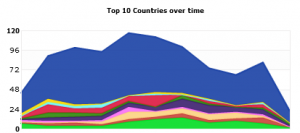Last week I received a comment response to my post on web analytics tools from your web host. Specifically, Andre from Logaholic pointed out that the differences in the web analytics numbers between Logaholic and Google Analytics is due to GA using page tagging which requires a Java supported browser. Therefore, visitors that have Java disabled or those that click away before the page tag loads are not accounted for. Well, Andre’s comments got me to thinking more about web analytics and page tagging.
In doing further research, it seems clear that there are advantages and disadvantages to using page tagging. Additionally, it appears that your decision of whether to use web server logs data or page tagging for your analytics data is really subjective based on the functionality of your website and what user behavior you feel should be given more importance in your data analysis.
For example, with page tagging (or data collection on the client side), the data you’ve collected is generally regarded as being more accurate than that of web server logs. But again, if you’ve got a lot of visitors that have cookies and JavaScript disabled, you’re going to be missing their information—whereas with web server logs, this data would be included. And, while page tag data can be collected faster and have more flexibility in terms of including certain variables, items such as multimedia files and redirects to other pages are not accounted for.
Looking at it in practical terms, if you’ve got a website that’s rich in downloadable multimedia files and or redirects to other places, you’re probably not going to get the best picture of site usage with page tagging. Also, since page tagging doesn’t account for visitors that immediately click away from your site, if your bounce rate is already high on Google Analytics, you may want to check your web server log data to see if you’ve actually had a lot more visitors. If so, you probably want to take a closer look at your site to see how you can keep more visitors there. And, as I mentioned before, because page tagging will not account for visitors that have JavaScript and cookies disabled, you really should take a look at your web server log data to see if there is a big discrepancy.
Given all the factors above, I would have to say in order to have the most complete picture of your web analytics, you really should make use of both methods. And as I mentioned in my previous post, if you have a cPanel web hosting plan, you can easily get access to your web server log data via the Logaholic tool. Additionally, you can implement Google Analytics on your site, and now you’ve got both methods of your web analytics data collection covered.


